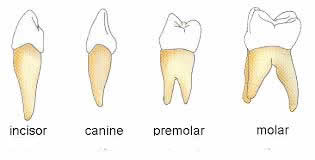Different Types of Teeth
Key Difference: Teeth are hard organs which are situated in the oral cavity. There are four main types of teeth which are classified according to their shape and structure. They all have specific functions related to the activity of eating. Incisors, canines, pre-molars and molars are the main types of teeth.
 Teeth are organs which are hard and are present in the oral cavity. The primary function of a tooth is chewing which helps to masticate bigger pieces into smaller particles. They also play an important role in speech. Teeth are composed of enamel, dentin, pulp, cementum and periodontal ligament. Animals use teeth for additional activities like ripping and tearing.
Teeth are organs which are hard and are present in the oral cavity. The primary function of a tooth is chewing which helps to masticate bigger pieces into smaller particles. They also play an important role in speech. Teeth are composed of enamel, dentin, pulp, cementum and periodontal ligament. Animals use teeth for additional activities like ripping and tearing.
The types of teeth depend upon the type of animal. For example, herbivores have different types of teeth than carnivores. Humans fall into the category of omnivores which eat both plants and other animals. Therefore, human have both sharp and flat molars. A normal human adult has 32 teeth which erupts by about that adult reaches the age of 13. This does not include wisdom teeth. The different types of teeth found in human oral cavity are –
 Incisors – A human adult has 4 incisors in each jaw which means eight incisors all together. These are the four front teeth in each arch. They have sharp thin edges to cut food. The flat apical surface assists in cutting food into smaller parts.
Incisors – A human adult has 4 incisors in each jaw which means eight incisors all together. These are the four front teeth in each arch. They have sharp thin edges to cut food. The flat apical surface assists in cutting food into smaller parts.
Canines – In total, there are four canine teeth, with two on each jaw. They are present at position adjacent to the four incisors. These are sharply pointed in shape and are also known as capsids. These are meant for dealing with tough food items like meat. These cone shaped teeth are therefore primarily used for tearing.
Premolars – These are used for grinding food. They are present next to the canine teeth. There are eight premolars in total, with four on each jaw. These are bigger and stronger than incisors and canines. Unlike incisors and canines, they have ridges which assist them in crushing and grinding food.
Molars – Molars are similar to premolars but tend to be wider and stronger than premolars. In addition to this, they have more ridges than premolars. They assist in swallowing of food. There are four Molars present in each jaw.
Wisdom teeth or third molars – These are additional molars which are not required at present. They were present in earlier times where they helped humans to chew tough plants. Now, they are just removed from the oral cavity so that no overcrowding of teeth takes place. They grow in form of molars in the back of the mouth and all in corners. They erupt by the age of twenty.
Considering other types of animals, omnivores are known for their sharp teeth which are good for biting and holding their pray. Therefore, their molars are also sharp. Herbivores depend upon plants only for their food, and therefore they have flat teeth, which means more molars. They make use of front teeth for cropping shears to clip leaves and stem.
Image Courtesy: monashdentalgroup.com, bio662.dyndns.info









Add new comment